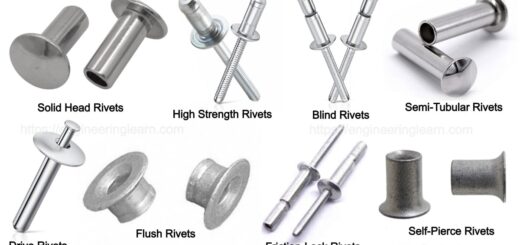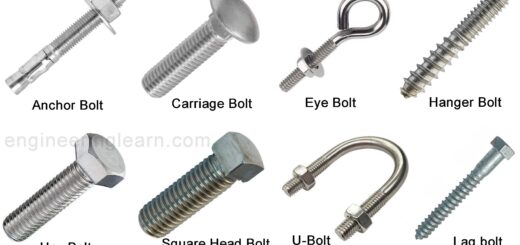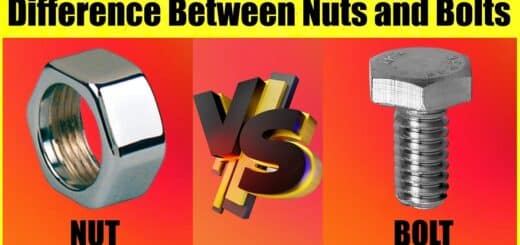Types of Motor Mounts & Their Uses [with Pictures]
![Types of Motor Mounts & Their Uses [with Pictures]](https://engineeringlearn.com/wp-content/uploads/2021/07/Motor-Mounts-1024x539.jpg)
What is Motor Mounts?
Types of Motor Mounts & Their Uses [with Pictures] :- Motor mounts are quite essential components of any machine or vehicle which connects the engine and the chassis. These are designed with an aim to absorb shocks, vibration and noise during the operation, which is very important for preventing the damage to both the motor as well as the chassis. This article will help you in learning about the different types of motor mounts along with their positions, their pros and cons, and comparison. Scroll down to learn more about these mounts.
8 Different Types of Motor Mounts
There are various types of motor mounts which are available in the market and can be selected according to the type of position in which they are found being fit.
1. Solid Rubber Engine Mounts
Solid rubber motor mounts is also termed as transmission mounts and these are the mounts which are specially made of solid rubber cushion that is bolted to the engine transmission along with the chassis through the steel-backed plates. The combination of such materials is responsible for the movement as well as the flexibility and is also found minimizing the shocks to the system. This is the factor which can extend the engine’s motor along with the other components of vehicles. These are the types of motors which are usually found in the cars and trucks.
This type of motor mount which is positioned in such a way to robust and hold the engine in place, to also absorb the vibration and noise well at a comparatively lower cost. Other than the quality, these are the types of motors which if not positioned properly can begin to crack and tear, particularly under a heavy load which generates more movement and reduced performance.
2. Hydraulic Motor Mounts
Hydraulic motor mounts are also termed as hydro motor mounts and is referred to as those motors which are filled with a fluidic gel or liquid. The hydraulic motor mounts are specially designed in order to dampen and absorb the vibrations of the engine before they reach the chassis. The primary use of such motors is to produce abundance of high and low frequency vibration, and are also preferred in vehicles or industries which are found having the noise to be at the minimum level.
These specific types of motor mounts are most popularly used in the automobile, marine and construction industry, as these are the ones which can be tuned in order to offer better performance over a broader range of conditions as compared to the standard rubber engine mounts, that tend to be selected in order to offer excellent performance over a relatively narrow range of conditions.
The components of hydraulic motor mounts are responsible for producing higher production costs result in higher expense. Therefore, they are not that budget-friendly as the fluid is also found to leak and collapse which been known to happen with the extensive use. These are the things which can be mitigated by the correct assessment of the conditions and production of a high quality mount and its position.
These types of motor mounts are found including glycol or hydraulic fluid and every any other type of fluidic substance which can help the motor in better functioning. This type of motor mount is mostly used in the four-cylinder motors with a motive to produce large amounts of vibration or noise. These motor mounts can also be used with any other type of motor while the noise levels can be kept to minimum.
3. Metal Motor Mounts
A metal motor mount is referred to as that motor mount which is found creating a stronger and secure connection within the engine and the chassis which also enables a high amount of power that needs to be transferred to the wheels and which also remains rigid under the condition of heavy load. Whereas, due to the perfect metal-on-metal connection, these are the types of motor mounts which are found transmitting most of the vibrations and noise.
4. Electronic Motor Mounts
Electronic motor mounts are referred to as those motor mounts which are designed in order to vary the stiffness and damping characteristics of the mount and to also reduce the noise and vibration, depending on the type of vehicle or machine and the load which it bears along with its speed. This machinery is monitored and fed back to the control system by the help of using sensors. Various methods of control are used in order to reduce the vibrations of the engine like the vacuum-actuator or a counter shake mechanism.
5. Polyurethane (PU) Motor Mounts
Polyurethane motor mounts are referred to as a longer-lasting alternative to rubber motor mounts which are found offering the benefits of rubber as well as solid steel mounts combined together. These are the properties which can provide an enhanced performance and tend to come at a higher cost. These motor mounts also tend to be less resistant to heat which can sometimes cause problems in an automotive application. Moreover, the bonding between PU and metal or stainless steel is quite difficult to achieve as compared to rubber.
6. Rigid Mounts
Rigid mounts are referred to as those motor mounts which is attached to the frame of the device along with the fasteners or bolts. Some of the rigid mounts can be built into the machinery or equipment or permanently welded in the required place. According to study, the rigid mounts are found having one of the most often used small motors rather than large ones. These motor mounts are responsible for providing the most accurate alignment within the motor and the surrounding mechanism which can also be damaged by the vibration under heavy-duty operation.
7. Resilient Mounts
Resilient motor mounts are referred to as those motor mounts which features a layer of rubber or insulation within the mount and the motor. This is the material which helps in order to reduce noise and vibration and which can be extended to the life of the motor along with all its related parts. Resilient motor mounts can be allowed for some flexibility and movement without compromising the performance of the motor. According to study, these are the motor mounts which can often be founded in the larger motors or in applications where the excessive noise or vibration can create problem. These are the motor mounts which can help in reducing the impact as soon as the motor starts and stops, which also minimizes the shocks to the surrounding system.
8. Face Mounts
Face mount motor are designed for the face mounting, or NEMA- C mounting, the motor gets attached directly to the surrounding components without the use of any standard mount. The installers are found using a NEMA C face mount adapter in order to adapt a face-mounted motor to any vehicle which is designed for another type of motor mount. These are the types of mount which have the bolts on the motor and passes through the pre-drilled holes in the motor casing and in the surrounding components or devices. These types of motor mounts are further classified which are again selected according to the requirement of the site. Face motor mounts are high in demand in the market and so is found in various types in the market which can be selected according to the usage.
Difference Between Solid Rubber & Hydraulic Motor Mounts
Solid rubber and hydraulic motor mounts are referred to as those mounts which are found having slightly different properties. This depends on the type of industry, budget and personal preference. A hydraulic motor mount is the one which can be tuned to exceed the performance of a solid rubber across a broader range. These are also referred to as those which tend to be more expensive and are even less durable than the solid rubber mounts. Therefore, opting for a solid rubber mount ensures long-lasting wear for lower load capacities and at a lower cost too. And so it is advised to consider your industry, budget and personal preference if you are looking to replace your motor mounts and try to get its position well set in order to get better results.
The motor mount is referred to as those which acts as a transition within the motor and the surrounding components and also allows the installers to secure the motor within the device. The right motor mount can be found having an extended life of the device whereas the wrong mount may result in excess vibration and a shortened lifespan for the motor. While choosing any motor mount one must take the time in order to match the type of mount accompanied with the application in order to maximize its performance at the required site.
Image Source :- vibracoustic, vulkan, akgmotorsport, bsfinc













